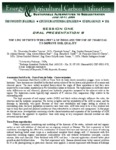Por favor, use este identificador para citar o enlazar este ítem:
http://www.alice.cnptia.embrapa.br/alice/handle/doc/1005560Registro completo de metadatos
| Campo DC | Valor | Lengua/Idioma |
|---|---|---|
| dc.contributor.author | TEIXEIRA, W. G. | pt_BR |
| dc.contributor.author | STEINER, C. | pt_BR |
| dc.contributor.author | SWAMI, S. N. | pt_BR |
| dc.contributor.author | MOREIRA, A. | pt_BR |
| dc.contributor.author | REIS, A. R. | pt_BR |
| dc.contributor.author | COSTA, D. G. | pt_BR |
| dc.contributor.author | CHAVES, F. C. M. | pt_BR |
| dc.contributor.author | MARTINS, G. C. | pt_BR |
| dc.contributor.author | SOUZA, G. K. de A. | pt_BR |
| dc.contributor.author | ARRUDA, M. R. | pt_BR |
| dc.date.accessioned | 2015-06-09T05:54:42Z | - |
| dc.date.available | 2015-06-09T05:54:42Z | - |
| dc.date.created | 2015-01-14 | pt_BR |
| dc.date.issued | 2004 | pt_BR |
| dc.identifier.citation | Trabalho apresentado no Energy and Agricultural Carbon Utilization: Sustainable alternatives to sequestration, 2004. | pt_BR |
| dc.identifier.uri | http://www.alice.cnptia.embrapa.br/alice/handle/doc/1005560 | pt_BR |
| dc.description | Amazonian Dark Earth ? Terra Preta de Índio. Characterization The Amazonian Dark Earth (ADE) or Terra Preta de Índio shows normally a plaggic, terric or hortic horizons. These horizons are identified by the dark matrix colors of the top layers, and presence of ceramics and charcoal pieces. The more widely accepted theory about the origin of these epipedons is that they were improved by Amerindian populations in Pre Colombian Indian settlements. The tophorizons on ADE sites show some differences on soil chemical, physical and hydraulic properties compared to the adjacent soils in the region. The tophorizon shows typically high amounts of P, calcium (Ca), magnesium (Mg) relative to the surrounding soils. The high amounts of soil organic matter (SOM) and black carbon strongly influence the color, the structure and the hydraulic properties. The texture is lighter and the workability of the ADE is easier, and the drainage is, habitually, very good. Because of their easy workability and longer lasting in relation to surrounding soils, the local population intensively uses those sites. ADE sites seem to be a very resilient soil type to keep their good soil physical qualities as when submitted to an intensive soil management. In this paper we discuss some investigations concerning a better characterization and expansion of the knowledge of ADE sites. Moreover the approach to reproduce those soils using as key component charcoal residues are also reviewed and discussed. Terra Preta reproduction Many experiment, monitoring and modeling of the dynamic of the water, nutrients and soil organic matter in soil with addition of charcoal are on ongoing research in Manaus. The first experiment at field conditions, investigating the effect of a combination of mineral fertilizers and charcoal as a mean of reducing nutrient leaching tested anual crops in a randomized complete block design with 15 treatments with five replication including organic amendment combinations with and without fertilization (compost, chicken manure, litter and charcoal). Plots fertilized with NPK and lime + charcoal application showed better plant growth as plots fertilized alone. Our first experiment with Banana showed some better mineral nutrition for N in the plants growing on plots were charcoal were applied. | pt_BR |
| dc.language.iso | eng | eng |
| dc.rights | openAccess | eng |
| dc.subject | Terra Preta de Índio | pt_BR |
| dc.subject | Sequestro de carbono | pt_BR |
| dc.title | The link between Terra Preta de Índio and the use of charcoal to improve soil quality. | pt_BR |
| dc.type | Artigo em anais e proceedings | pt_BR |
| dc.date.updated | 2015-06-09T05:54:42Z | pt_BR |
| riaa.ainfo.id | 1005560 | pt_BR |
| riaa.ainfo.lastupdate | 2015-06-08 | pt_BR |
| Aparece en las colecciones: | Artigo em anais de congresso (CPAA)  | |
Ficheros en este ítem:
| Fichero | Descripción | Tamaño | Formato | |
|---|---|---|---|---|
| 54557db90cf2bccc490ccd51.pdf | 113,91 kB | Adobe PDF |  Visualizar/Abrir |









